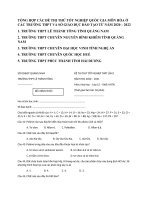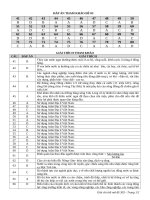Pediatric emergency medicine trisk 202
Bạn đang xem bản rút gọn của tài liệu. Xem và tải ngay bản đầy đủ của tài liệu tại đây (152.4 KB, 4 trang )
FIGURE 40.6 Anteroposterior and lateral views of two-fragment triplanar fracture. L, lateral;
M, medial; P, posterior; A, anterior.
FIGURE 40.7 Lateral view of the ankle. ATFL, anterior talofibular ligament; PTFL, posterior
talofibular ligament; CFL, calcaneofibular ligament.
Injuries Associated With Ankle Sprains
Approximately 7% of ankle sprains are accompanied by osteochondral fractures
of the talus. The medial dome is more commonly fractured than the lateral dome.
Avulsions of the peroneus brevis tendon from the base of the fifth metatarsal have
been observed in up to 14% of patients with ankle ligament ruptures. If this injury
occurs in children younger than 15 years, the avulsed fragment is usually an
apophysis and is considered an S-H type I injury, often called a pseudo-Jones
fracture. In older patients, the fracture is more distal on the fifth metacarpal at the
metaphyseal–diaphyseal junction and is known as a Jones fracture.
FIGURE 40.8 Ankle eversion injury. ATFL, anterior talofibular ligament.
TABLE 40.4
CLASSIFICATION OF ANKLE SPRAINS
Grade I: Mild
sprain
Grade II:
Moderate sprain
Grade III: Severe
sprain
Ligament injury
Swelling
Tenderness
Functional loss
Minor
Mild
Mild, local
Minimal
Joint stability
Stable
Near complete tear
Moderate
Moderate, diffuse
Ambulates with
difficulty
No/mild instability
Complete rupture
Severe
Marked
Inability to bear
weight
Unstable
EVALUATION AND DECISION
History
Trying to obtain a reliable history in ankle injuries can be difficult. Commonly,
the description is: “I twisted it and it hurts.” Nevertheless, the mechanism of
injury, if obtainable, can provide a clue to the diagnosis. Other questions include
the following: (i) When did the injury occur? (ii) Did swelling occur immediately
or gradually? (iii) Is there a history of any previous injury to that limb? and (iv)
Does the patient have a history of any other medical problems—osseous,
neurologic, or muscular disease?
A history of fever, rash, or other joint involvement, in combination with a
history of minimal or no trauma, suggests nontraumatic diagnoses such as septic
joint, arthritis, or collagen vascular disease.
Physical Examination
General Inspection
Look for obvious deformities, open wounds, loss of anatomic landmarks, local
swelling, and ecchymosis. If an obvious deformity is present, keep manipulation
of the extremity to a minimum and assess neurovascular status promptly. Any
break in the skin may communicate with the joint space or constitute an open
fracture. The need for antibiotic coverage should be evaluated immediately.
Neurovascular Evaluation









